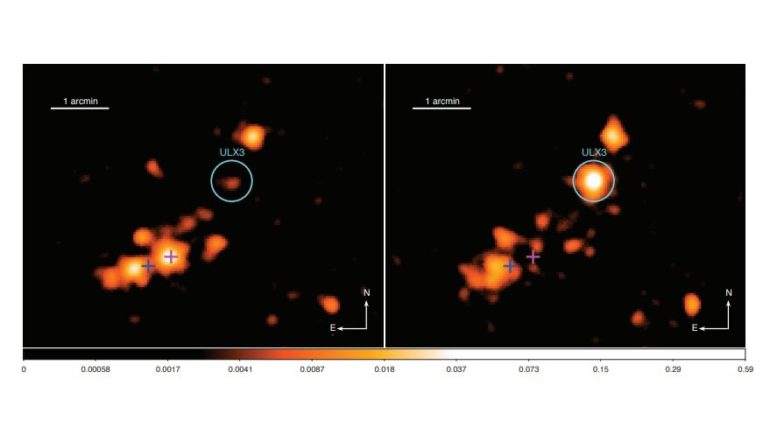An international team of astronomers has identified a new ultraluminous X-ray source (ULX) in the galaxy NGC 7090. The object, designated NGC 7090 ULX3, was found using NASA’s Swift spacecraft. The finding is detailed in a paper published November 17 on the arXiv pre-print repository.
ULXs are point sources in the sky that are so bright in X-rays that each emits more radiation than a million suns emit at all wavelengths. They are less luminous than active galactic nuclei, but more consistently luminous than any known stellar process. Although numerous studies of ULXs have been conducted, the basic nature of these sources still remains unsolved.
Usually there is one ULX per galaxy in galaxies which host them, however some galaxies were found to contain many such sources. At a distance of about 31 million light years from the Earth, NGC 7090 is one of such galaxies. Previous observations have found that it hosts two highly variable and transient ULXs, which received designations NGC 7090 ULX1 and NGC 7090 ULX2.
Now, based on the observations conducted with Swift, astronomers led by Dominic Walton of the University of Cambridge, UK, report the detection of another ULX in NGC 7090 in a new study. The research was complemented by data from NASA’s Nuclear Spectroscopic Telescope Array (NuSTAR) and Chandra space telescopes, as well as ESA’s XMM-Newton satellite.
“Here we report on the discovery and characterisation of a new, transient ULX in NGC7090 (z = 0.00282), utilizing observations with the Neil Gehrels Swift Observatory, XMM-Newton, NuSTAR and Chandra,” the astronomers wrote in the paper.
NGC 7090 ULX3 reached a peak luminosity of approximately 6.0 duodecillion erg/s and is the latest addition to the short but rapidly growing population of transient ULXs. It appeared to have a relatively stable luminosity, at a level of 0.1 duodecillion erg/s, prior to its recent transition into the ULX regime. NGC 7090 ULX3’s period of activity seems to have lasted more than seven months, as it has been almost persistently detected by Swift during the 2019–20 monitoring campaign.
The astronomers underlined that such a strong long-timescale variability suggests that NGC 7090 ULX3 may be a ULX pulsar system. However, the observations have not detected any significant X-ray pulsations from this source. Further monitoring of NGC 7090 ULX3 is needed to get more insights into the true nature of the accretor in this system, what would put more constraints on the properties of this source.
“The nature of the accretor powering this new ULX therefore remains uncertain. (…) Further observations that can provide improved constraints on the timing properties and/or the evolution of the accretion flow will be required to reveal the nature of ULX3,” the authors of the paper concluded.
Astronomers investigate an ultraluminous X-ray source in NGC 5055
More information:
A New Transient Ultraluminous X-ray Source in NGC 7090, arXiv:2011.08870 [astro-ph.HE] arxiv.org/abs/2011.08870
2020 Science X Network
Citation:
New transient ultraluminous X-ray source detected in the galaxy NGC 7090 (2020, November 27)
retrieved 30 November 2020
from https://phys.org/news/2020-11-transient-ultraluminous-x-ray-source-galaxy.html
This document is subject to copyright. Apart from any fair dealing for the purpose of private study or research, no
part may be reproduced without the written permission. The content is provided for information purposes only.



